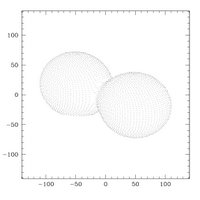An Evening with Jon Stewart and The Daily Show
A little less than a month ago, I felt glad for the first time* that I am living in Ohio instead of somewhere, you know, interesting.** There was this election or something two years ago that a lot of people cared about, and the general consensus is that since the votes in Ohio were the last ones to be counted that it matters more than other equally divided states with more efficient vote counting techniques. But whatever the cause, Jon Stewart is hosting the Daily Show in Columbus, OH (specifically on Ohio State's campus, maybe?) for the next two weeks. Indecision 2006! ... The Midwest Midterm Midtacular!!!!
Of course, by the time this was officially announced (i.e., when I first heard about it), tickets for the actual taping of the Daily Show itself were already sold out.*** So, instead, they decided to have "An Evening with Jon Stewart and The Daily Show" in the large basketball arena/colliseum on October 28, free and just for students. I've had my ticket in my desk drawer for weeks, totally stoked and completely convinced that it was going to be downright awesome.
It wasn't.
The basic format was "moderated." Jon Stewart did make fun of this a few times, granted. The dean of the College of the Arts asked some questions from the thousands that had been emailed in, and there seemed to be only two types of questions. There were the lame questions that just wasted everyone's time and weren't even funny, like "How do you think the world will end?" Then there were the really good questions that were mostly sidestepped by the cast because there was no good way to answer it in a short (moderated) format. The only decent question receiving a decent (i.e., actually funny) answer was: "Do you want to see Bush, Cheney, and Rumsfeld remain in the political scene so as to provide your show with more content?" After a curt "No," it was explained to the audience that everything Cheney has ever said publicly is simply ... wrong. And he shot a guy in the face for crying out loud.
The most annoying part was that acoustics in the building were horrible. Everyone kept asking each other, what'd he just say? What was that? Oh, and the dean doing the moderating clearly didn't know how to use a microphone. At some point handheld mics were finally brought out, but even then, it was very difficult to follow the conversation. And what's it say when the dean is introduced and there is a lot of booing from the crowd? And how come she got that gig anyhow, instead of someone who would have been more comfortable? There were large screens (... like you'd see at a basketball game ...), but the lighting was so poor that it wasn't any easier to see what was happening by looking at the screen than by looking directly at the very far away stage.
No, that actually wasn't the most annoying part. The most annoying part was that they clearly hadn't prepared anything of any value. Most of the entire hour and a half was filled by showing any clip pertaining to Ohio. Now, I'm a pretty big fan of Jon Stewart and the Daily Show, well, I like them, see, but I don't own a television and have never had access to cable, so I'm more of a fan who never watches the show per se, see, but at least the clips were new to me. But I could watch them on my computer at home and actually hear what was being said instead. And I'm certain that most of the people there had actually seen most of the clips before.
No, that's not true either. The most annoying part of the evening was the fact that I was in a very large room with thousands of Ohio State undergrads. And, oh yes, Saturday was also homecoming and *gasp* there was a home football game involving the Buckeyes slaughtering Minnesota 44-0. Now, there's this ... cheer? ... where someone will yell, "O! H!" and people will yell back, "I! O!" It's one thing during the game, but people will do it freaking walking down the street and then they'll give you nasty looks and accuse you of being from Michigan if you don't yell back. So put thousands of undergrads in a very large room still high from a wholly expected win, and they'll start doing this odd yelling thing. Jon Stewart commented, "I do not understand this ritual, but it seems comforting to you ..." Pretty much the entire evening, every answer to a question involved either saying the magic word, "Ohio," which would in turn elicit raucous cheers from the sharp-thinking crowd, or mistakeningly admitting that there are other states in the Union and getting lots of boos.
Ugh. I may be surrounded by cows and Ohioans, but at least my vote will count this year. And I'll still be watching the Comedy Central election day coverage with an odd pride about me.
* Not the first-first time, but just got along with the story, okay?
** Sure, the cost of living is extraordinarily less than anywhere Interesting, but isn't that the kind of thing you only actively notice if you're living in the expensive place with no residiual money to take advantage of the interesting stuff?
*** Seriously people, don't tell someone that if they email such&such address they can get tickets when there are already no more tickets left. It won't put anyone in a better mood.





